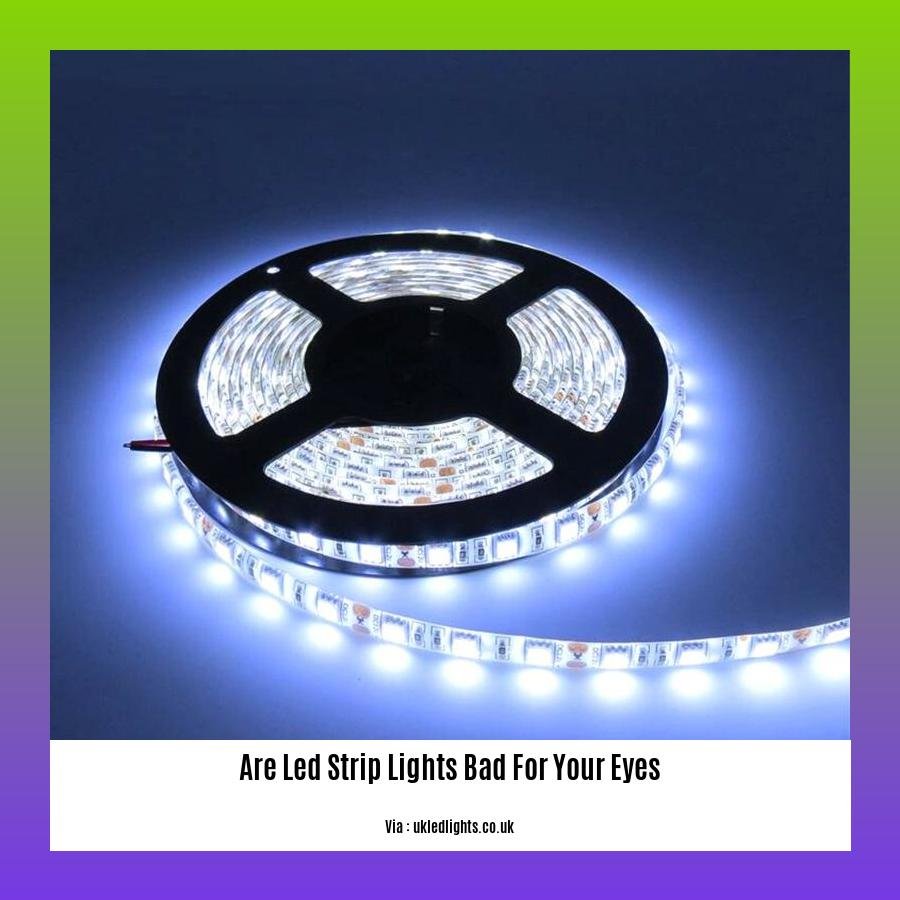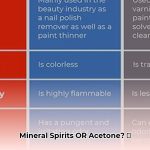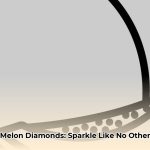Seeking to illuminate your space with LED strip lights? Before you do, learn about their potential impact on your eyes. While these lights offer energy efficiency and design versatility, emerging research suggests they may pose certain risks. In this article, [Are LED Strip Lights Bad for Your Eyes: Understanding the Risks and Benefits], we’ll delve into the evidence, separating facts from myths to help you make informed decisions about LED strip light usage.
Key Takeaways:
-
LED light strips can cause eye strain or discomfort due to blue light or glare.
-
LED radiation can cause irreversible damage to the retina.
-
The potential negative effects of LED light strips on the eyes may vary from person to person.
-
LED light strips are often used in office spaces and retail environments due to their energy efficiency and lower levels of light intensity.
-
Avoid staring directly at bright LED lights for prolonged periods.
-
Adjust the brightness of LED fixtures and screens to reduce potential eye strain.
Are LED Strip Lights Bad for Your Eyes? Understanding the Risks
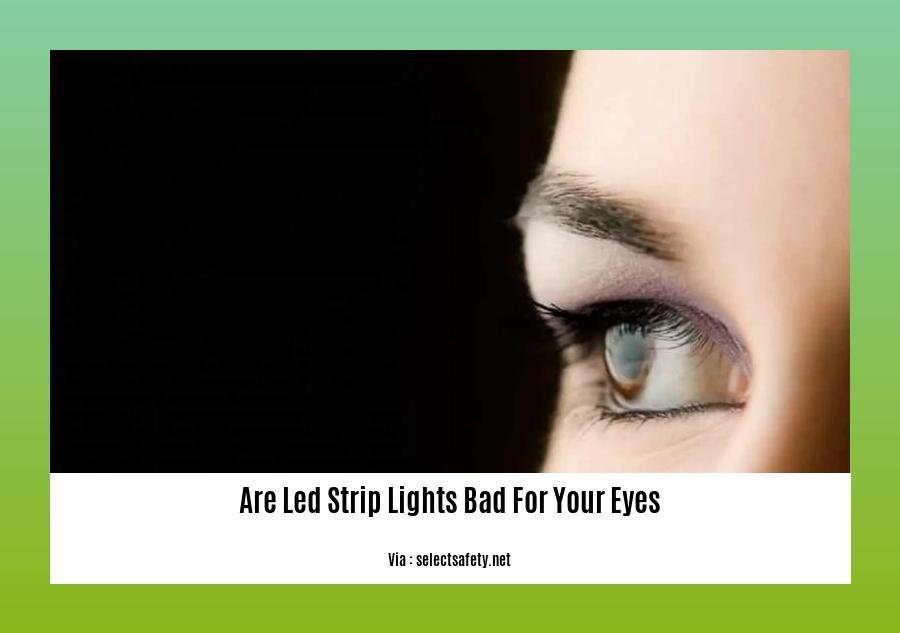
Navigating the Potential Impact of LED Lights on Your Vision
With the increasing popularity of LED strip lights in homes, offices, and commercial spaces, concerns about their potential impact on eye health have emerged. While LED lights offer undeniable energy efficiency and versatility, it’s crucial to understand the risks associated with prolonged exposure to their light emissions. In this article, we’ll delve into the scientific evidence and provide practical guidance on minimizing potential eye strain and damage.
Blue Light: A Double-Edged Sword
LED lights emit significant amounts of blue light, a high-energy visible light that can penetrate deep into the eye, reaching the retina. While blue light is essential for regulating circadian rhythms and alertness, excessive exposure can lead to eye strain, sleep disturbances, and even retinal damage.
Flicker and Glare: The Hidden Culprits
LED strip lights often exhibit flicker and glare, which can further aggravate eye discomfort. Flicker refers to the rapid pulsing of light, while glare is the unpleasant sensation caused by excessive brightness or improper light distribution. Both can contribute to headaches, eye fatigue, and reduced visual performance.
Minimizing the Risks: A Proactive Approach
While the potential risks of LED strip lights are real, there are several steps you can take to mitigate them and protect your eyes:
-
Choose LED Lights with Lower Blue Light Emission: Opt for LED strip lights that emit lower levels of blue light. Look for lights with a correlated color temperature (CCT) below 4000K, which indicates a warmer, less blue-shifted light.
-
Dim the Lights When Possible: Avoid using LED strip lights at full brightness, especially for extended periods. Dimming the lights can reduce the intensity of blue light and glare, making them less harsh on your eyes.
-
Take Regular Breaks: When working or spending time in areas with LED strip lights, take frequent breaks to rest your eyes. Step away from the light source and focus on a distant object for a few minutes to reduce eye strain.
-
Use Blue Light-Blocking Glasses: Consider using blue light-blocking glasses, especially if you’re exposed to LED lights for prolonged periods. These glasses can help filter out harmful blue light, reducing the risk of eye strain and damage.
-
Maintain Proper Lighting Conditions: Ensure that your workspace or living area has adequate ambient lighting to reduce the contrast between the LED strip lights and the surrounding environment. This can help minimize glare and eye discomfort.
Conclusion: Striking a Balance
LED strip lights offer numerous benefits, but it’s essential to be mindful of their potential impact on eye health. By understanding the risks associated with LED lights and taking appropriate precautions, you can enjoy the benefits of these versatile lights while protecting your precious eyesight. Remember, prevention is key—adopt these simple measures and consult an eye care professional if you experience persistent eye strain or discomfort.
Are you concerned about the fire hazards associated with LED lights? Click here to find out are LED lights a fire hazard.
Worried about the potential harm LED lights may cause to your eyes? Find out the truth are LED lights bad for your eyes.
Seeking affluent black neighborhoods in Texas? Explore our comprehensive list of affluent black neighborhoods in Texas.
Mitigating the Risks: Provide practical tips and strategies for reducing the risk of eye problems from LED strip lights.
Yup, LED strip lights have become all the rage. Mood-setting ambiance, accent lighting—oh, the possibilities. But hold on a sec. Before you go all in on these bright babies, let’s talk risks. Yes, risks to your precious peepers.
Blue Light: The Culprit
The blue light emitted by LED strip lights can penetrate deep into your eye, reaching the retina. Too much of this blue stuff can lead to eye strain, sleep disturbances, and even retinal damage. Not cool.
Flicker and Glare: The Annoying Duo
Flicker and glare are common issues with LED strip lights. These can give you headaches, eye fatigue, and make it harder to see clearly. Bummer.
Mitigating the Risks: Provide practical tips and strategies for reducing the risk of eye problems from LED strip lights.
-
Choose LED lights with lower blue light emission: Look for lights with a CCT (correlated color temperature) below 4000K. This means less blue light and less risk to your eyes.
-
Dim the lights when possible: When you don’t need full brightness, dim those lights. It’ll reduce the intensity and give your eyes a break.
-
Take regular breaks: Give your eyes a rest every 20 minutes or so. Look away from the screen and focus on something else for a few minutes. It’ll help prevent eye strain.
-
Consider blue light-blocking glasses: These glasses can help filter out blue light, reducing your exposure to this harmful light.
-
Maintain proper lighting conditions: Make sure your room is well-lit. Avoid areas with too much contrast or glare. Proper lighting can help reduce eye strain.
Key Takeaways:
- LED strip lights emit blue light, which can harm your eyes.
- Flicker and glare from LED lights can cause eye strain and headaches.
- You can reduce the risks by choosing LED lights with lower blue light emission, dimming the lights, taking regular breaks, considering blue light-blocking glasses, and maintaining proper lighting conditions.
Sources:
- Risk Mitigation Strategies: Types & Examples
- 20 Project Risk Examples and Their Mitigation Strategies
Types of LED Strip Lights: Describe the different types of LED strip lights available and their potential impact on eye health.
LED strip lights are versatile lighting options used in various applications, from home decor to commercial displays. While they offer many benefits, it’s essential to understand their potential impact on eye health.
Key Takeaways:
-
AC220V LED Strips: These high-voltage lights operate directly on AC220V power, making them suitable for outdoor applications like building outlines and street lighting.
-
DC LED Strip Lights: These low-voltage lights require a power supply to convert AC power. They’re commonly used for indoor applications such as cove lighting, accent lighting, and DIY projects.
-
LED Rope Light: Similar to traditional rope light, LED rope lights use LED technology to provide 360-degree illumination, making them ideal for decorative purposes and creating soft ambient lighting.
-
High-Output LED Strips: Designed for special purposes, these LED strips feature high-power LEDs from reputable manufacturers. They’re ideal for commercial applications like task lighting, retail displays, and architectural lighting.
Regarding eye health, some types of LED strip lights can emit significant blue light, which can penetrate deep into the eye, reaching the retina. Excessive blue light exposure may lead to eye strain, sleep disturbances, and even retinal damage. Additionally, flicker and glare from LED strip lights can contribute to headaches, eye fatigue, and reduced visual performance.
To minimize the potential risks, consider choosing LED lights with lower blue light emission, dimming the lights when possible, taking regular breaks to rest your eyes, and maintaining proper lighting conditions to minimize contrast and glare.
Citations:
-
How Many Different Types of LED Strip Lights Are There? – LEDStripLight.com
-
The Ultimate Guide on Buying LED Strip Lights – LED Supply Blog
Choosing Safe LED Strip Lights: Provide guidance on selecting LED strip lights with features that minimize the risk of eye problems, such as lower blue light content and flicker-free operation.
Navigating the world of LED strip lights can be tricky, especially when it comes to understanding their impact on eye health. While these lights offer vibrant illumination, it’s crucial to make informed choices to minimize potential risks. Let’s dive into the world of LED strip lights and explore how you can select safe ones for your space.
Key Takeaways:
-
Blue Light Blues: Prolonged exposure to blue light emitted by LED strip lights can disrupt sleep patterns and cause eye strain. Opt for lights with lower blue light content (below 4000K) to reduce the impact on your eyes.
-
Flicker-Free Operation: Flickering lights are not just annoying; they can strain your eyes. Choose LED strip lights that operate smoothly without any flickering to ensure eye comfort.
-
Brightness Matters: The brightness of the LED strip lights should suit your needs and the intended application. Consider dimmable lights or those with adjustable brightness levels to create the perfect ambiance.
-
Quality Counts: Invest in high-quality LED strip lights from reputable brands that adhere to industry standards. Look for certifications like UL or ETL for added assurance of safety and quality.
-
Installation and Maintenance: Proper installation and maintenance are crucial for the longevity and safety of your LED strip lights. Follow the manufacturer’s instructions carefully and ensure regular cleaning to prevent dust and dirt buildup.
-
Responsible Disposal: When it’s time to dispose of your LED strip lights, do it responsibly. Electronic waste can contain harmful substances, so find local recycling centers or programs that handle e-waste safely.
Avoiding the Glaring Traps:
Choosing safe LED strip lights is all about making informed decisions. Here are some additional pointers to help you avoid potential pitfalls:
-
Avoid lights with incorrect voltage: Using LED strip lights with an incorrect voltage can lead to safety hazards and damage to the lights.
-
Consider the IP rating: If you plan to use the lights outdoors or in humid areas, ensure they have an appropriate IP rating for water resistance.
-
Be mindful of overheating: LED strip lights can generate heat, so proper ventilation is essential to prevent overheating and potential fire hazards.
-
Consult professionals: If you have concerns about the safety or installation of LED strip lights, don’t hesitate to consult a qualified electrician or lighting expert.
Safe Lighting, Happy Eyes:
Choosing LED strip lights with care can minimize the risk of eye problems and create a safe and enjoyable lighting experience. By considering factors like blue light content, flicker-free operation, and proper installation, you can enjoy the benefits of LED strip lights without compromising your eye health. Remember, it’s always better to be safe than sorry when dealing with potential hazards to your eyesight.
References:
FAQ
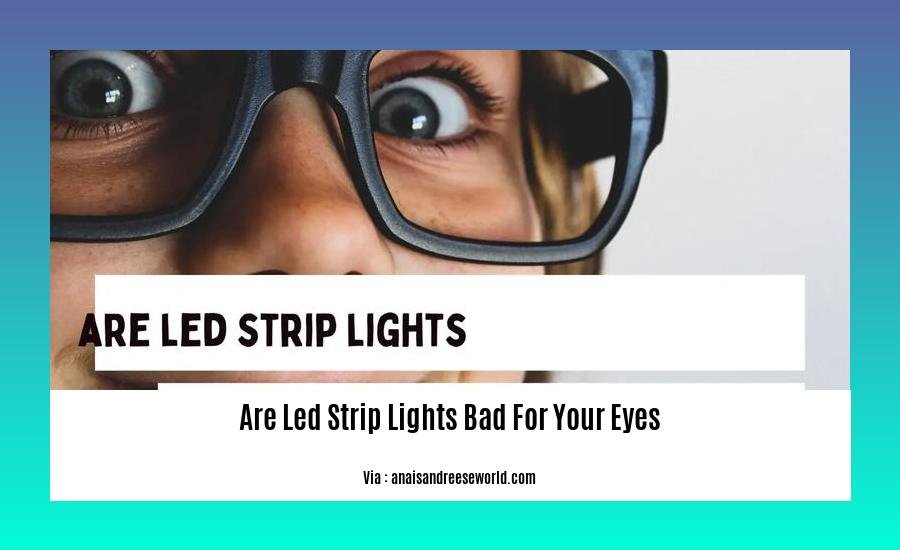
Q1: Can LED strip lights cause eye strain or discomfort?
A1: Yes, LED strip lights may emit blue light or produce glare, which can contribute to eye strain, discomfort, and fatigue.
Q2: Is the potential harm of LED strip lights on the eyes permanent?
A2: According to some research, prolonged exposure to LED radiation might potentially lead to irreversible damage to the retina. However, more studies are needed to fully understand the long-term effects.
Q3: Are all LED strip lights harmful to the eyes?
A3: Not all LED strip lights pose the same level of risk. High-quality LED strip lights with proper brightness and color temperature settings can minimize potential eye strain.
Q4: How can I use LED strip lights safely to minimize eye strain?
A4: To reduce the potential risks, consider factors like brightness, color temperature, installation location, and duration of exposure. Avoid direct and prolonged eye contact with bright LED strip lights.
Q5: Are there any alternatives to LED strip lights that are less harmful to the eyes?
A5: Some alternative lighting options that may be gentler on the eyes include incandescent bulbs, halogen bulbs, and warm-colored LED lights with lower blue light emission.
Are LED Strip Lights Bad for Your Eyes? Examining the Potential Risks and Benefits
[Are LED Strip Lights Bad for Your Eyes? Examining the Potential Risks and Benefits]: As LED strip lights gain popularity in home and commercial settings, concerns about their impact on eye health arise. While LEDs offer energy efficiency and design versatility, understanding their potential risks and benefits for the eyes is essential. Join us as we delve into the research and evidence surrounding LED strip lights’ effects on vision and well-being.
Key Takeaways:
- Eye Damage:
- High levels of exposure to LED strip lights can cause cataracts, a clouding of the eye lens leading to impaired vision.
- LED lights can cause dry eyes because of their blue light emission.
-
Some studies suggest the potential for irreversible damage to the retina from LED radiation.
-
Precaution Measures:
- Use LED strip lights in moderation, avoiding prolonged and direct exposure.
- Wear protective eyewear or install blue light filters on devices to reduce the impact of blue light.
-
Maintain adequate lighting conditions to prevent eye strain.
-
References:
- Are LED Strip Lights Bad for Your Eyes | What Are the Risks?
- Are LED Lights Damaging Your Retina? – Cleveland Clinic
Are LED Strip Lights Bad for Your Eyes? Unveiling the Potential Risks and Benefits
What if your trendy decor had an unforeseen impact on your visual health? Recent discussions have centered on the potential adverse effects of LED strip lights on our eyes. However, is there any truth to these claims? Let’s dive into the research and separate fact from fiction.
Unraveling the Potential Risks
-
Eye Strain: LED strip lights, particularly those emitting blue light, can cause eye strain. Prolonged exposure to blue light, a high-energy visible light, can disrupt the body’s natural sleep cycle and lead to digital eye strain.
-
Circadian Rhythm Disturbance: The blue light emitted by LED strip lights can suppress melatonin production, a hormone that regulates sleep. This disruption can lead to difficulty falling asleep and poor sleep quality.
-
Glare and Discomfort: The brightness and intensity of LED strip lights can cause glare and visual discomfort, especially in poorly designed lighting installations. This can lead to headaches, eye irritation, and difficulty focusing.
Unveiling the Potential Benefits
-
Energy Efficiency: LED strip lights are highly energy-efficient, consuming less electricity compared to traditional incandescent or fluorescent lights. This can result in significant cost savings and reduced environmental impact.
-
Long Lifespan: LED strip lights have a remarkably long lifespan, lasting up to 50,000 hours or more. This reduces the need for frequent bulb replacements and maintenance.
-
Versatility and Customization: LED strip lights offer a wide range of colors and adjustable brightness levels, allowing for customization and mood setting. They can enhance the ambiance of a room or create stunning visual effects.
Striking a Balance: Safe Use of LED Strip Lights
-
Moderate Use: Avoid prolonged and excessive exposure to LED strip lights, especially those emitting high levels of blue light. Take breaks and maintain a safe distance from the light source.
-
Blue Light Filters: Consider installing blue light filters on devices or using protective eyewear to reduce exposure to harmful blue light. This can help minimize the risk of eye strain and sleep disturbances.
-
Adequate Lighting Conditions: Ensure that you have adequate and appropriate lighting conditions in your environment. Avoid using LED strip lights as the sole source of illumination, as this can lead to eye strain.
-
Proper Installation: Install LED strip lights strategically to avoid glare and visual discomfort. Ensure that they are properly shielded and directed away from direct eye contact.
Remember, moderation and responsible use are key to minimizing potential risks associated with LED strip lights. By following these guidelines, you can enjoy the benefits of these versatile lighting solutions while protecting your precious eyesight.
-
Want to know if LED lights are a fire hazard? Learn how safe they are before installing them in your home.
-
Are you concerned about the impact of LED lights on your eyes? Explore the facts and make an informed decision for your well-being.
-
Looking for the most affluent black neighborhoods in Texas? Discover the hidden gems where success and culture thrive.
Practical tips for safe use of LED strip lights, such as limiting exposure time and using appropriate shielding or filters.
Key Takeaways:
- Prolonged exposure to blue light emitted by LED strip lights can strain your eyes and lead to digital eye strain.
- Blue light from LED strip lights can affect your sleep quality and make it harder to fall asleep by suppressing melatonin production.
- Improper installation or high-intensity LED strip lights can cause glare and discomfort, leading to headaches and eye irritation.
- LED strip lights consume less electricity and reduce environmental harm, offering energy efficiency.
- LED strip lights have an exceptionally long lifespan of up to 50,000 hours, minimizing maintenance and bulb replacements.
- LED strip lights offer a wide range of colors and adjustable brightness levels, allowing for customization and aesthetic enhancements.
Practical Tips for Safe Use:
- Moderate Use: Don’t use LED strip lights for extended periods, especially those high in blue light output.
- Blue Light Filters: Wear blue light filters or use them on devices to minimize harm from blue light.
- Adequate Lighting Conditions: Light your space appropriately; don’t depend solely on LED strip lights.
- Proper Installation: Install LED strip lights strategically to prevent glare by avoiding direct eye contact.
Additional Tips:
- Maintain a safe distance between your eyes and the LED strip lights to reduce the effects of direct lighting.
- Diffuse the Light: Use diffusers or covers to distribute the light evenly and minimize glare.
- Color Temperature: Use LED strip lights with a color temperature of 2700K or lower in spaces like bedrooms to create a relaxing atmosphere.
- Safe Installation: Ensure the voltage of LED strip lights matches power supply requirements. Avoid extension cords with USB LED strip lights as they can cause problems.
Choose High-Quality LED Strip Lights:
– Brightness Control: Look for LED strip lights with adjustable brightness levels to suit different needs and moods.
– Flicker-Free: Choose flicker-free LED strip lights to prevent eye strain and headaches.
– Safety Certifications: Ensure the LED strip lights are certified by reputable organizations like UL or CE for safety and quality standards.
Benefits of LED Strip Lights:
- Versatile: LED strip lights can be used in various applications, including home decor, task lighting, and commercial displays.
- Long-Lasting: LED strip lights have a lifespan of up to 50,000 hours, making them a durable and cost-effective lighting option.
- Energy-Efficient: LED strip lights consume less energy compared to traditional lighting sources, resulting in lower energy bills and a reduced carbon footprint.
Conclusion:
By following these guidelines, you can safely enjoy the benefits of LED strip lights while minimizing potential risks to your eyes. Remember, moderation and proper installation are key to ensuring a safe and pleasant lighting experience.
Citations:
- Are LED Strip Lights Safe? Tips for Ensuring Safety
- LED Strip Light Safety: What You Need to Know for Your Home
Comparison of LED Strip Lights with Other Commonly Used Lighting Sources in Terms of Their Potential Impact on Eye Health
Fear not! LED strip lights can be a safe and stylish addition to your home’s lighting scheme if used correctly. However, they emit blue light, like many of our modern devices, and prolonged exposure to blue light can take a toll on our eyes. Let’s dive into the potential risks and benefits of LED strip lights and compare them with other lighting options.
Key Takeaways:
- Blue Light and Eye Strain: Prolonged exposure to blue light, present in LED strip lights, can lead to eye strain, fatigue, and sleep disruption.
- Flickering: Some LED strip lights can flicker, causing eye strain and headaches. Choose high-quality, flicker-free lights to avoid this issue.
- Glare: Improperly installed or high-intensity LED strip lights can cause glare, leading to discomfort and headaches.
- Other Lighting Sources: Incandescent and fluorescent lights emit less blue light and flicker, but they have other drawbacks like energy inefficiency and shorter lifespan.
- Safe Use Practices: Moderate use, blue light filters, proper installation, and adjustable brightness levels can enhance eye comfort and minimize risks associated with LED strip lights.
What’s The Big Deal About Blue Light?
LED strip lights, like our beloved smartphones and computer screens, emit blue light. While blue light is essential for regulating our sleep-wake cycle, excessive exposure can disrupt our circadian rhythm and make it harder to fall asleep. Additionally, blue light scatters more easily than other colors, causing eye strain and digital eye fatigue.
Flicker, Flicker, Little Star:
Some low-quality LED strip lights may flicker, especially when dimmed or powered by an unstable power source. This flickering can be barely noticeable, but it can still wreak havoc on our eyes, causing strain, headaches, and fatigue. Opt for high-quality, flicker-free LED strip lights to avoid these issues.
Shine Bright Like a Diamond (Or Not):
LED strip lights can be incredibly bright, and shining them directly into your eyes can cause glare, discomfort, and even headaches. To avoid this, install LED strip lights strategically, shield them from direct eye contact, and use diffusers or covers to disperse light evenly.
Comparison with Other Lighting Sources:
| Lighting Source | Blue Light Emission | Flickering | Energy Efficiency | Lifespan |
|---|---|---|---|---|
| LED Strip Lights | Moderate to High | Possible | High | Long |
| Incandescent Bulbs | Low | Uncommon | Low | Short |
| Fluorescent Lights | Low to Moderate | Possible | Moderate | Moderate |
Creating a Safe Space for Your Eyes:
- Moderate Use: Avoid excessive and prolonged exposure to LED strip lights, especially those high in blue light output.
- Blue Light Filters: Employ blue light filters on devices and use protective eyewear to minimize exposure to harmful blue light.
- Proper Installation: Install LED strip lights strategically to prevent glare and discomfort, shielding them from direct eye contact.
- Adjustable Brightness: Use LED strip lights with adjustable brightness levels to create a comfortable ambiance.
- Consider Other Lighting Options: Combine LED strip lights with other lighting sources, such as incandescent or fluorescent lights, to create a well-balanced and eye-friendly lighting environment.
In a Nutshell:
LED strip lights can be a great addition to your home, but it’s crucial to use them wisely. Moderate use, proper installation, adjustable brightness, and awareness of potential risks can help you enjoy the benefits of LED strip lights without compromising your eye health. So, go ahead, add a touch of ambiance to your space, but do it safely!
Sources:
- The Truth About LED Strip Lights and Eye Health
- Are LED Strip Lights Bad for Your Eyes?
Importance of responsible use and further research to fully understand the long-term effects of LED strip lights on eyes.
Like any lighting technology, understanding the responsible use and promoting further research is crucial when it comes to LED strip lights and their impact on our eyes. While they offer numerous benefits, their excessive or improper use might pose potential health risks.
**Key Takeaways:**
- **Eye Strain and Digital Eye Strain:** Prolonged exposure to high-intensity LED strip lights can cause eye strain, headaches, and digital eye strain, especially when used in close proximity.
- **Circadian Rhythm Disruption:** Blue light emitted by LED strip lights can suppress melatonin production, affecting sleep quality and making it harder to fall asleep.
- **Glare and Discomfort:** Improperly installed or high-intensity LED strip lights can cause glare and visual discomfort, leading to headaches and eye irritation.
- **Retinal Damage:** While rare, studies suggest that prolonged exposure to high-intensity blue light may contribute to retinal damage, particularly in children whose eyes are still developing.
- **Responsible Use:** Moderate use, avoiding direct eye contact, maintaining appropriate viewing distance, and using blue light filters can help minimize potential risks.
- **Further Research Needed:** Long-term studies are necessary to fully understand the cumulative effects of LED strip lights on eye health, especially in children and individuals with pre-existing eye conditions.
LED strip lights can enhance our living spaces, but we must prioritize responsible use and encourage research to ensure their long-term safety. Until more comprehensive data is available, practicing moderation and implementing safety measures are essential for safeguarding our eyes.
References:
- The Effects of LED Lighting on Eye Health
- Blue Light from LED Devices: A Review of the Biological and Health Effects
FAQ
Q1: Can LED strip lights cause eye damage?
A1: Prolonged exposure to LED strip lights can potentially lead to eye problems such as cataracts, dry eyes, and retina damage. However, these risks are generally associated with excessive and direct exposure to bright LED lights.
Q2: Are all LED strip lights bad for the eyes?
A2: Not all LED strip lights are harmful to the eyes. Choosing high-quality LED strip lights with adjustable brightness levels, warmer color temperatures, and proper installation practices can minimize potential risks.
Q3: How can I use LED strip lights safely?
A3: To ensure eye safety when using LED strip lights, avoid prolonged and direct exposure. Consider installing diffusers or covers to disperse light evenly and reduce glare. Additionally, opt for LED strip lights with lower color temperatures (around 2700K) for comfortable lighting in bedrooms or living areas.
Q4: What are the benefits of using LED strip lights?
A4: LED strip lights offer various benefits, including energy efficiency, versatility, and customization options. They are commonly used for accent lighting, task lighting, and decorative purposes. Their flexible nature allows for easy installation in various applications.
Q5: Are there any alternatives to LED strip lights?
A5: If you are concerned about the potential risks of LED strip lights, there are alternative lighting options available. These include traditional incandescent bulbs, halogen bulbs, and compact fluorescent lamps (CFLs). Each type of lighting has its own advantages and disadvantages, so it’s important to consider your specific needs and preferences when making a choice.
